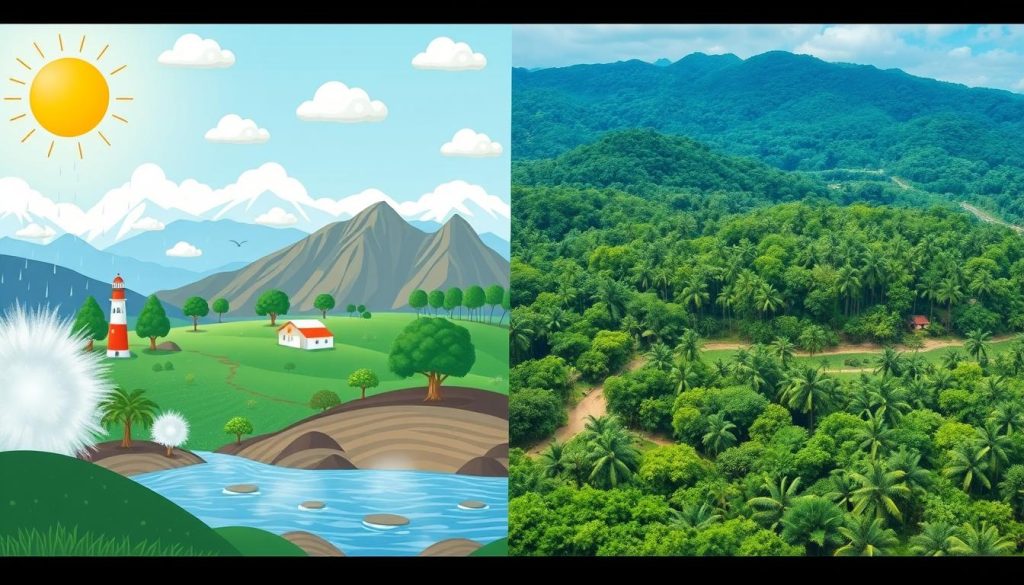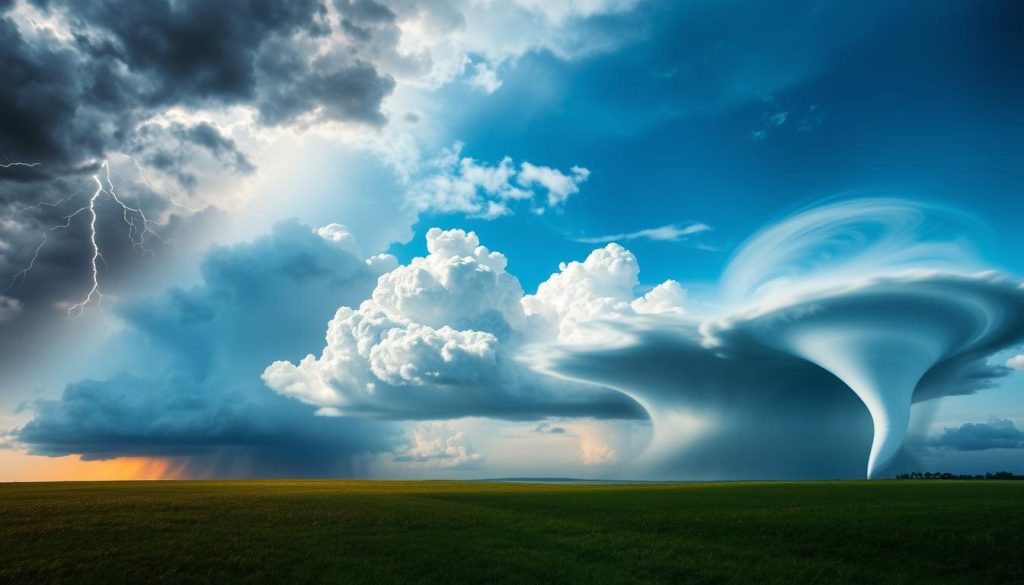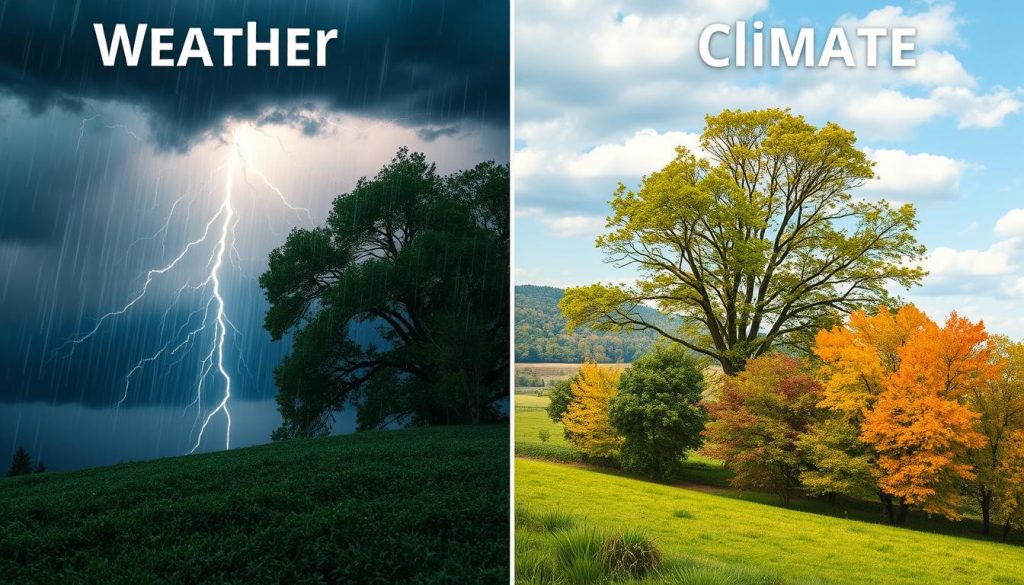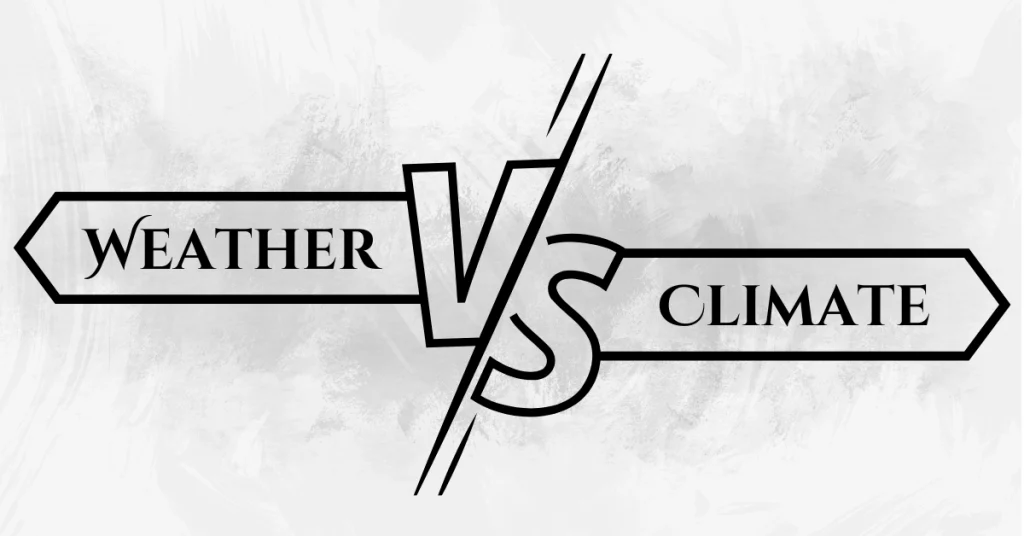“Climate is what you expect, weather is what you get,” said Robert Henson, a famous climatologist. He explained how weather vs climate affect us every day. They shape our short-term experiences and long-term environment.

Meteorology shows us how weather and climate are different. It’s not just about temperature. It’s about how global factors work together.
Weather and climate are like two dancers. They move together but in their own way. Knowing this helps us understand and predict changes in our environment.
Also Read: RAM vs ROM: Key Differences Explained
Key Takeaways
- Weather represents short-term atmospheric conditions
- Climate describes long-term environmental patterns
- Meteorological studies help understand complex atmospheric systems
- Geographic location significantly influences weather and climate
- Understanding these differences aids environmental predictions
Understanding Weather and Atmospheric Conditions
Weather is a dynamic system of atmospheric interactions. It shapes our daily experiences. The dance of temperature and short-term changes creates a fascinating landscape.

Atmospheric conditions are complex. They include temperature, humidity, air pressure, and wind. Scientists study these to predict weather and climate changes.
Daily Temperature Variations and Patterns
Temperature patterns show our atmosphere’s heartbeat. From cool mornings to hot afternoons, our planet’s temperature changes. Local geography, solar radiation, and conditions all play a role.
| Temperature Range | Time of Day | Typical Characteristics |
|---|---|---|
| 40-50°F | Early Morning | Cool, minimal solar radiation |
| 60-75°F | Late Morning | Warming trend, increasing solar input |
| 75-85°F | Afternoon | Peak temperature, maximum heat |
Precipitation Types and Formation
Precipitation trends show the water cycle’s complexity. Rain, snow, sleet, and hail form through unique conditions. Clouds form when water vapor condenses, falling to Earth based on temperature and pressure.
“Weather is a way of explaining something that happens between the ground and the sky.” – Unknown Meteorologist
Short-term Weather Forecasting Methods
Modern weather forecasting uses advanced technology and computer modeling. Meteorologists use satellite imagery, radar, and data to predict weather. These predictions help communities prepare for challenges.
Difference Between Weather vs Climate
Environmental science teaches us about weather and climate. Weather is short-term, like today’s weather. Climate is long-term, like what we see over years.

Meteorologists say weather is daily. It’s about today’s temperature, humidity, and wind. Climate looks at these over decades or centuries.
“Climate is what you expect, weather is what you get.” – Climate Science Experts
Temperature changes help us tell weather from climate. A hot day doesn’t mean climate change. A cold winter doesn’t mean global cooling. We need lots of data to understand climate.
| Weather | Climate |
|---|---|
| Short-term atmospheric conditions | Long-term atmospheric patterns |
| Changes hourly or daily | Changes over decades or centuries |
| Localized measurements | Regional or global patterns |
Knowing the difference helps us study the environment. It helps us predict the future and adapt to climate change. Looking at precipitation and temperature tells us about big changes in nature.
Geographic Factors and Climate Zones
Our planet’s climate is made up of many parts. These parts work together in a special way. They make different weather patterns in different places.
Impact of Latitude on Climate Patterns
Latitude is very important for weather. Places near the equator don’t have big temperature changes. But, places near the poles have big changes with the seasons.
The sun’s angle also affects the weather. It changes how hot or cold it is and how much rain falls.
Ocean Currents and Regional Climate
Ocean currents move heat around the world. They change the weather in different areas. For example, the Gulf Stream makes the weather in Western Europe warmer.
This creates special weather spots with their own feel.
| Ocean Current | Geographic Region | Climate Impact |
|---|---|---|
| Gulf Stream | North Atlantic | Moderates temperatures in Western Europe |
| Humboldt Current | South Pacific Coast | Creates arid conditions in coastal Peru |
| Kuroshio Current | Northwestern Pacific | Brings warm waters to Japan’s coastal regions |
Elevation Effects on Local Weather
How high a place is changes the weather. Mountains can make some areas dry and others cold. For every 1,000 feet up, it gets about 3.5 degrees Fahrenheit colder.
“Geography is destiny when it comes to climate and weather patterns.” – Climate Science Research Institute
Knowing about these factors helps us understand weather changes. Each place has its own weather story because of how it interacts with the environment.
Conclusion
Weather and climate are complex systems that affect our world a lot. As we learn more, we see how they are connected. Climate change is a big problem that needs our full understanding.
Global warming is a big worry for everyone. Knowing the difference between weather and climate is key. This helps us get ready for changes in our environment.
Learning about weather and climate helps us make better choices for the planet. Even though weather can change fast, studying climate gives us important clues. We need to keep learning and teaching to fight climate change.
Our journey to understand the sky and earth is never-ending. Scientists keep working on new ways to see how weather and climate are linked. By staying up to date, we can help protect our planet.
FAQ
What’s the basic difference between weather and climate?
Weather is what happens every day, like today’s weather. Climate is the long-term weather pattern in a place over many years. Think of weather as your mood and climate as your personality.
How do meteorologists predict short-term weather?
Meteorologists use computers, satellites, and weather stations to predict the weather. They look at temperature, humidity, and wind to make forecasts.
How do geographic factors impact climate?
Places near the equator are warmer. Mountains are cooler. Coastal areas have milder temperatures because of the ocean.
What causes seasonal weather variations?
The Earth’s tilt and orbit around the sun cause seasons. Different parts of the Earth get more or less sun, leading to different weather patterns.
How does climate change affect weather patterns?
Climate change leads to more extreme weather. This includes stronger storms, droughts, and unpredictable temperatures. It’s caused by global warming and pollution.
Can local weather be different from the regional climate?
Yes! Local areas can have their own weather. Things like cities, hills, and water can change the weather from the rest of the area.
How do scientists track long-term climate trends?
Scientists look at old weather records, ice cores, and tree rings. They also use satellites and models to understand climate changes over time.
Why is understanding weather and climate important?
Knowing weather and climate helps us plan and prepare. It’s important for farming, managing resources, and making safe choices for our homes and environment.



